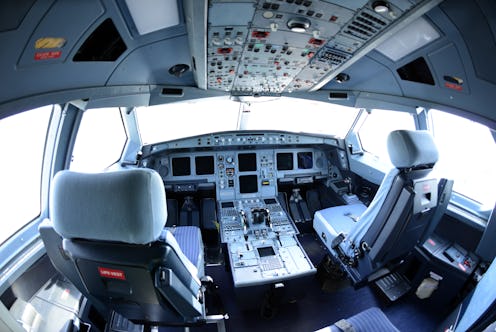News
Why Can A Pilot Lock Out Another From The Cockpit?
At a press conference Wednesday, authorities stated plainly that one of the pilots on Germanwings Flight 9525 deliberately crashed the plane while the other pilot was locked out of the cockpit. The shocking claim raises an important question about aircraft design: how does a cockpit lock system work, and why is the door so hard to break? Like many other aircraft manufacturers, Airbus reinforced the strength of its cockpit door after 9/11, when terrorists were able to enter the cockpit and hijack the planes. While the additional safety measure was designed to deter similar terrorist attacks, nobody expected the plane's own pilot to take advantage of it.
On Wednesday, the New York Times quoted a French military official involved in the investigation saying that based on the flight's audio recording, one pilot left the cockpit and then was not able to get back in. "You can hear he is trying to smash the door down," he described to the Times.
How is it that neither the plane's own pilot nor the other crew members were unable to open the cockpit door? After the 9/11 attacks, the U.S. Federal Aviation Authority (FAA) increased security measures on all planes, with one of the priorities being cockpit safety. In a 2002 press release, Airbus, the manufacturer of the aircraft that carried Germanwings Flight 9525, introduces a new, much more secure, door shortly after 9/11.
The press release describes the door:
The new cockpit door protects the crew from unauthorized entry while also delivering a number of safety contingencies. It features reinforced attachments, a reinforced and bullet proof main door panel, an escape panel, electrical door latching, an electronic entry pad located in the cabin, and a warning light and buzzer in the cockpit. In addition, a toggle control in the cockpit enables the crew to control access to the cockpit and secure the door in case of need.
Sounds like the Fort Knox of cockpit doors. But the description does emphasize that the crew should be able to open the door and access the cockpit at all times. What could have happened on the Germanwings flight that prohibited this?
According to Carsten Spohr, chief executive of Lufthansa, the parent company of Germanwings, the electronic entry code could have been overridden by the pilot inside the cockpit. He explained at a press conference on Thursday that every pilot and crew member is required to memorize the code by heart, but it can be changed from inside the cockpit with the push of a button, which then enforces a five-minute override — just long enough to crash a plane. When that happens, Spohr said, not even weapons can open the door.
And it's highly unlikely that the code was overridden by accident.
Aviation analyst Scott Hamilton told CNN:
[If the pilot] was being denied access after punching in the correct code, it meant that somebody was seriously trying to keep him out.
Another procedural detail that could have prevented the crash is the two-person requirement for the cockpit. CNN's aviation analyst, David Soucie, told the outlet that while American carriers required two people to be in the cockpit at all times — if one pilot left, he would have to be replaced by a flight attendant — not all international carriers have the same policy.
In fact, Spohr confirmed during the press conference that Lufthansa does not require a flight attendant to replace the pilot if he leaves the cockpit, because European regulations do not require it. He also emphasized that the pilot did not do anything wrong by leaving the cockpit.
While officials are still trying to gather what happened exactly on Germanwings Flight 9525, and, if it is confirmed to be true, why the co-pilot crashed the plane deliberately, one thing is more certain: it might be time to reassess and update cockpit door regulations to factor in scenarios beyond hijackings.Images: Getty Images (4)
